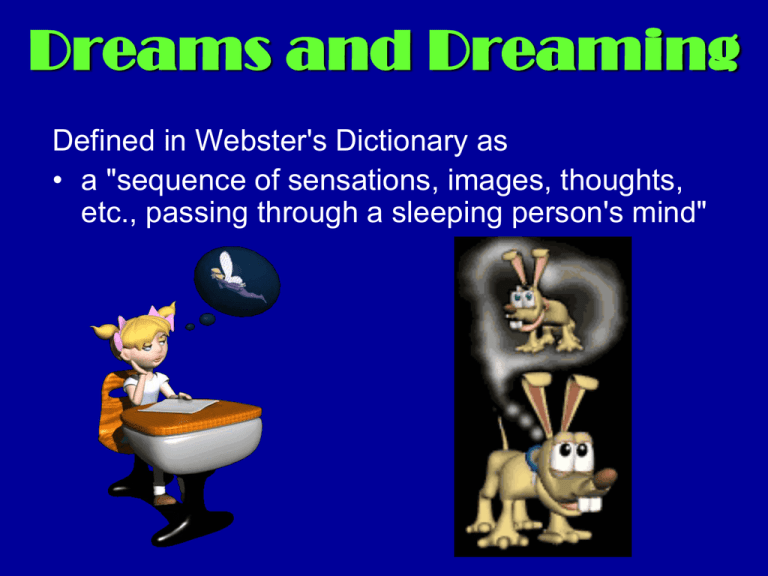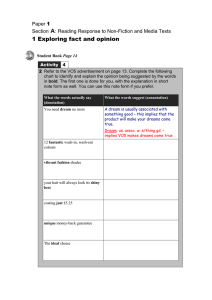Dreams and Dreaming
advertisement

Dreams and Dreaming Defined in Webster's Dictionary as • a "sequence of sensations, images, thoughts, etc., passing through a sleeping person's mind" Do we all dream? • No non-dreamers, just non-recallers! • Average 4-5 dreams per night • Morning dreams more vivid due to longer REM sleep Oneirology The scientific discipline of dream research The most famous dream researcher was Freud Two Parts of a Dream (according to Freud) Dreams of Unconscious Wishes Manifest Content – the remembered storyline of a dream – who’s in the dream, what happens Two Parts of a Dream Latent Content –the underlying meaning of a dream The mc is the representation of the lc thus disguising the real meaning of the dream Dream Interpretation This type of therapy is dangerous…why?? Types of Dreams Daydreams – a level of consciousness between sleep and wakefulness. – It occurs during our waking hours when we let our imagination carry us away Why do we daydream? • They can help us prepare for future events • They can substitute for impulsive behavior Lucid Dreams • The conscious perception of one's state while dreaming – occurs when you realize you are dreaming – "Wait a second. This is only a dream!" – results in a much clearer ("lucid") experience and usually enables direct control over the content of the dream Nightmares • Dreams of particular intensity, with content that the sleeper finds disturbing – related either to physiological causes, such as a high fever – or to psychological ones, such as unusual trauma or stress in the sleeper's life Reoccurring Dreams • Recurring dreams repeat themselves with little variation in story or theme. Have You had one??? Dreams of Absent Minded Transgression (DAMT) • Dreams where the individual dreaming absent mindedly performs an action that they have been trying to stop – withdrawal dreams • EX: a smoker trying to quit dreams of lighting a cigarette • Subjects that have had DAMT dreams have reported awaking with intense feelings of guilt Fantasy Prone Personalities • Someone who imagines and recalls experiences with lifelike vividness and who spends considerable time fantasizing These are the types of dreams you will use for your dream journal! To Satisfy our own Wishes “Wish-fulfillment theory” • • Freud – “dreams are the key to understanding our inner conflicts” Dreams are our expressions of our wishes To File away Memories Information – Processing Theory – sorting and sifting through information to aid memory storage or memory removal To develop and preserve neural pathways Physiological function theory • provides stimulation for our brain To make sense of random activity in the brain Activation-synthesis Theory • • The minds attempt to make sense of random neural activity This might explain why many dreams do not make sense

